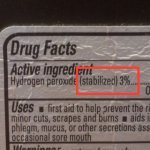Using Hydrogen Peroxide for Cleaning
Using hydrogen peroxide for cleaning is practical, non-toxic and cheap! It kills bacteria, viruses, and mold, and can be used for lots of tough household jobs.
Even though I’ve been using hydrogen peroxide for years, I’m still finding more uses and learning more uses.
To clean walls, windows, and countertops
Just put some 3% hydrogen peroxide into a spray bottle. Spray it on and wipe it off as you would with other household cleaners.
Hydrogen peroxide is generally anti-bacterial and anti-viral, so it makes sense to use it as a household cleaner. However, it does take time to work, so the short amount of contact time in cleaning counters and windows probably won't kill all the tiny pathogens in your house. On the other hand, it's a step in that direction, and if you want to really sanitize something, you can leave the hydrogen peroxide for a longer time. (This page talks more about uses for disinfection.)
I’ve use hydrogen peroxide, vinegar and plain soap for most of my general housecleaning. I’m impressed with what a good job peroxide does on mirrors. It seems that the more ways I use hydrogen peroxide for cleaning, the more ways I want to try....
To clean floors
You’ll probably want to use hot water, so the easiest way to accomplish this (and also make a 3% solution of hydrogen peroxide), is to put a gallon of hot water into a bucket and then add 1 cup of 35% hydrogen peroxide. Use the temperature of water you’d like to use on the floor, and then add the concentrated peroxide. (This is an approximate dilution, which is fine for floor cleaning, no need to be exact. See the mixing page, though, if you want exact proportions.)
Another great option is to use sodium percarbonate mixed in hot water.
Another option is to use a half gallon of very hot water, and add a half gallon of 3% hydrogen peroxide. This will result in a solution that is 1.5% hydrogen peroxide, and, obviously, mixing it this way will cool the mixture down quite a bit. 1.5% is also fine for washing floors.
You can add some plain soap to the solution if you wish.
Finally, if you don’t mind using cold water to clean the floor, you can just spray some 3% hydrogen peroxide onto the floor from your spray bottle. That's what I usually do. This also works well for day-to-day cleaning up gunk on the floor, and disinfects as you go along.
To clean toilets
Splash 3% hydrogen peroxide around the toilet rim and onto your toilet brush, then scrub the toilet as usual. Also use 3% hydrogen peroxide on a sponge to clean the rest of the toilet surfaces, and the floor around the toilet.
If the toilet is stained, adding a small amount (maybe a cup?) of 35% hydrogen peroxide to the toilet bowl, and leaving it overnight will help a lot. This only works on the area that is under the water, however, not stains above the water level. For heavy duty stains, you may need to repeat this treatment.
Hydrogen peroxide won't remove hard water marks (but vinegar will).
To clean showers and mildew
Spray 3% hydrogen peroxide onto the walls of the shower and let it sit for a while. For tiles that have mold or mildew, this will start to loosen it up and clean it out. Depending on the amount of mold and mildew, you may need to leave the solution on longer, or repeat this treatment. Certainly using hydrogen peroxide, over time, will reduce or prevent mildew and mold from developing.
Advantages of using hydrogen peroxide for cleaning
First off, it is anti-bacterial, anti-fungal, anti-mold and anti-mildew. Whew!
Secondly it is non-toxic for people, plants, household animals, and the earth. (Don’t forget that whatever household cleaners you use do end up going back to the earth, rivers and oceans eventually. In most cases, cleaning products will go through the sewage system first, but it all goes back to the environment eventually.)
Third, since hydrogen peroxide can be used for cleaning so many different things, it can simplify the number of different cleaning products you need to keep around. (This particular advantage occurs to me more over time, as I’m slowly trying out hydrogen peroxide for more different kinds of cleaning.)
Fourth, bought in concentrated form and in bulk, using hydrogen peroxide for cleaning is very inexpensive.
And, finally, using hydrogen peroxide for cleaning tends to keep your sponges, mops, and scrubbie pads a whole lot cleaner. (They'll all get a bit of disinfecting every time you use them.)
There are different types of hydrogen peroxide. I use food grade hydrogen peroxide, in general, for everything. (The other grades of hydrogen peroxide tend to have some stabilizers in them. Since I buy 35% food grade peroxide in large amounts, it is easy to use it for everything.)
Related Pages
- Cleaning carpet stains
- Homemade carpet cleaning solution
- Using Sodium Percarbonate, a powdered form of hydrogen peroxide
- Cleaning yellowed plastic and stained plastic
- Home uses of hydrogen peroxide for disinfection
- Hydrogen peroxide dilution chart for making 3% from 35%
Return from using hydrogen peroxide for cleaning to the home page for using hydrogen peroxide
Subscribe to Hydrogen Peroxide Explorers' Newsletter
Our newsletter will keep you up to date on new pages added, plus some Adventures you can try at home:
No worries! Your email will be used ONLY to send you newsletters.
(Gallon):
(5 pounds):
For some links, I receive ad commissions, at no cost to you. More info here.
Site Search:
Subscribe to our newsletter (free):
Note: Products shown are sold by Amazon. This site does NOT sell hydrogen peroxide.
Do you like this site?




